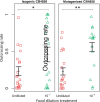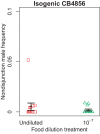Outcrossing in Caenorhabditis elegans increases in response to food limitation
- PMID: 38516572
- PMCID: PMC10954511
- DOI: 10.1002/ece3.11166
Outcrossing in Caenorhabditis elegans increases in response to food limitation
Erratum in
-
Correction to: Outcrossing in Caenorhabditis elegans increases in response to food limitation.Ecol Evol. 2024 Jun 3;14(6):e11497. doi: 10.1002/ece3.11497. eCollection 2024 Jun. Ecol Evol. 2024. PMID: 38832141 Free PMC article.
Abstract
Theory predicts that organisms should diversify their offspring when faced with a stressful environment. This prediction has received empirical support across diverse groups of organisms and stressors. For example, when encountered by Caenorhabditis elegans during early development, food limitation (a common environmental stressor) induces the nematodes to arrest in a developmental stage called dauer and to increase their propensity to outcross when they are subsequently provided with food and enabled to develop to maturity. Here we tested whether food limitation first encountered during late development/early adulthood can also induce increased outcrossing propensity in C. elegans. Previously well-fed C. elegans increased their propensity to outcross when challenged with food limitation during the final larval stage of development and into early adulthood, relative to continuously well-fed (control) nematodes. Our results thus support previous research demonstrating that the stress of food limitation can induce increased outcrossing propensity in C. elegans. Furthermore, our results expand on previous work by showing that food limitation can still increase outcrossing propensity even when it is not encountered until late development, and this can occur independently of the developmental and gene expression changes associated with dauer.
Keywords: C. elegans; dauer; food restriction; mating system; offspring diversity; outcrossing; selfing; self‐fertilization; starvation; stress.
© 2024 The Authors. Ecology and Evolution published by John Wiley & Sons Ltd.
Conflict of interest statement
The authors declare that they have no competing interests.
Figures


References
-
- Agrawal, A. F. (2009). Spatial heterogeneity and the evolution of sex in diploids. American Naturalist, 174, S54–S70. - PubMed
-
- Alvarez, O. A. , Jager, T. , Kooijman, S. A. L. M. , & Kammenga, J. E. (2005). Responses to stress of Caenorhabditis elegans populations with different reproductive strategies. Functional Ecology, 19, 656–664.
-
- Armbruster, P. , & Reed, D. H. (2005). Inbreeding depression in benign and stressful environments. Heredity, 95, 235–242. - PubMed
Grants and funding
LinkOut - more resources
Full Text Sources

